
Have you ever wished there was a way to get your online courses, community, and event scheduled all in one place?
If so, then Skool is the online community platform you’ve been looking for. While the Skool platform has every major community feature, it’s not without its fair share of limitations.
From its user-friendly interface to gamification elements, we’ll explore every nook and cranny to help you decide if Skool fits your learning journey.
Skool at a Glance: An Overview of the Learning Community
When looking for an online course platform, you might miss the option to have a community. And while looking for dedicated community platforms, you might also look for course-building features.
And even when you get both, you might miss the gamification and event scheduling features.
Founded by Sam Ovens, Skool is an integrated online community platform that solves this problem by incorporating courses, community interactions, and event schedules into one centralized location.
Skool offers a variety of features to do just that. Here’s a quick overview:
- Community management tools: Skool comes with a number of tools to help you create and manage your community, including discussion forums, live chat, direct messaging, and event calendars.
- Course hosting: Skool has a simple course builder and a course content editor to help you create and manage your courses. To organize complex courses, it also allows you to group content into categories and sub-categories (aka modules and sets).
- Gamification: Creating a community isn’t enough. And with an array of incentive and gamification elements, Skool understands this. It offers student engagement functions like leadership boards, levels, points, prizes, and gems to encourage member interactions.
- Events: Skool has its own calendar system to help you create and manage events without integrating it with a third-party tool.
And while Skool does not have native video hosting, it integrates well with YouTube, Wistia, Loom, and Vimeo.
Let’s discuss these features in more detail:
Skool Community Platform: Key Features That Impress
Skool is a great fit for edupreneurs and community builders who prioritize collaboration and connection with their course viewers or simply wish to create a collaborative environment with their audiences.
Considering that Skool’s major focus is on fostering collaboration, let’s start with Skool’s major selling point – its community.
Connect, Collaborate, and Thrive: Discover Skool’s Community Builder
Community and engagement are at the heart of Skool, and it shows through the emphasis they place on building a thriving learning community.
You can create groups that serve as containers for your community, where your team members and viewers enrolled in your course can actively engage.
Creating your own group on Skool is also a breeze – all done in just a few clicks.
Just sign into the platform, and you’re ready to get started. Simply give your group a name, choose between private or public settings, and kick off with a 14-day free trial.
That’s it. You can now start inviting members to your group.
You have a couple of quick options to extend invitations.
The first is through email – just type in their email address in Skool’s dashboard itself, and they’ll receive a personalized email from you. The email will contain an invitation to join your group; all they need to do is click the provided button. It’s quick, hassle-free, and provides a seamless onboarding experience to your members.
Alternatively, you can share a personalized invite link. Potential members will go through a membership approval process where you can either approve or decline their request.
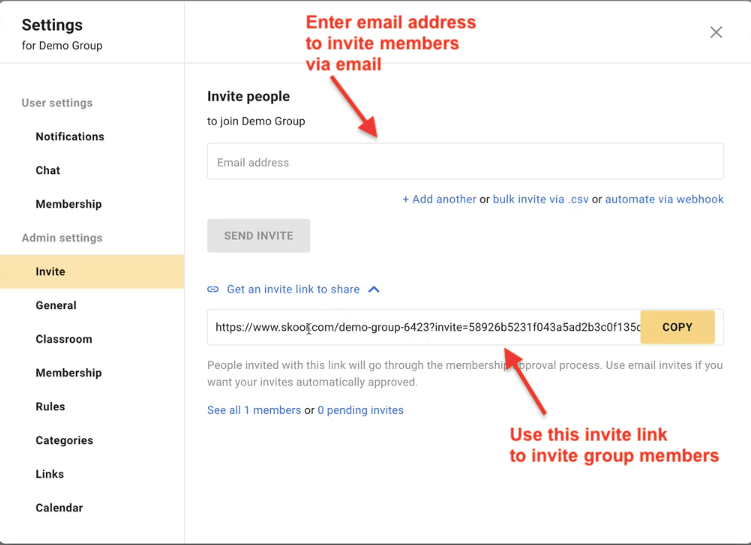
For bulk invites, you can use a CSV file to upload members’ emails and instantly send them invitations, bypassing the approval process.
Skool also provides native integration with Webhooks, which lets you automate the process and trigger invite emails for specific criteria.
We also like that Skool creates a member directory, where the admin and other members view individual member profiles to learn more about fellow community members.
These community members can share posts, like content, receive comments, and even chat with each other. Both the admin and the members can also add images, videos, links, polls, emojis, and gifs to their posts, making it easier to interact in a more informal environment.
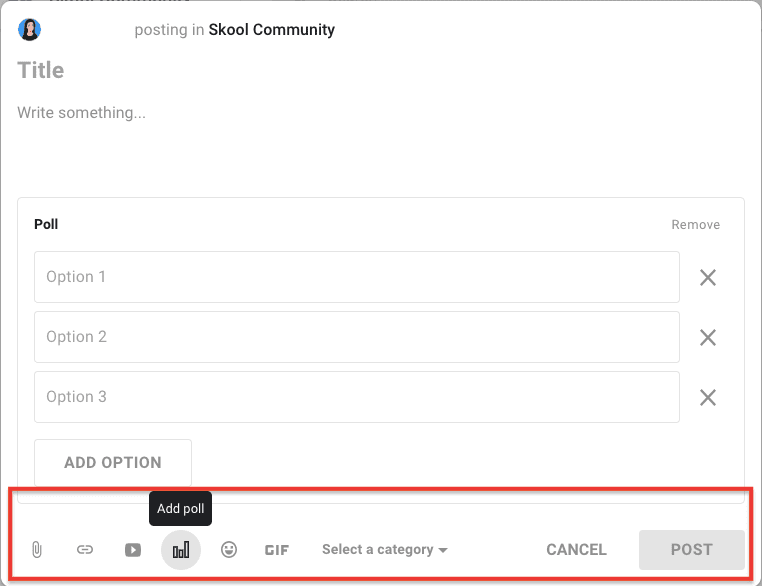
When it comes to the appearance of your community on Skool, there’s little room for full customization. You’ll have to stick with Skool’s default settings.
That said, you do have some branding options which allow you to upload a group icon and cover image. You can also add a description, customize the URL, and create rules to set expectations for your members.
There’s another unique community posting feature Skool offers.
You can add categories to your community on Skool. For example, you can group your discussions/community posts into categories like “Product related questions” or “Announcements” to keep things organized.
Plus, you get to set different permissions for each category. It’s up to you – let anyone post and view, or maybe only admins and mods can post while everyone can still view.
You can also moderate the content and pin important posts to the top.
Once your community is up and running, here’s how it will appear:
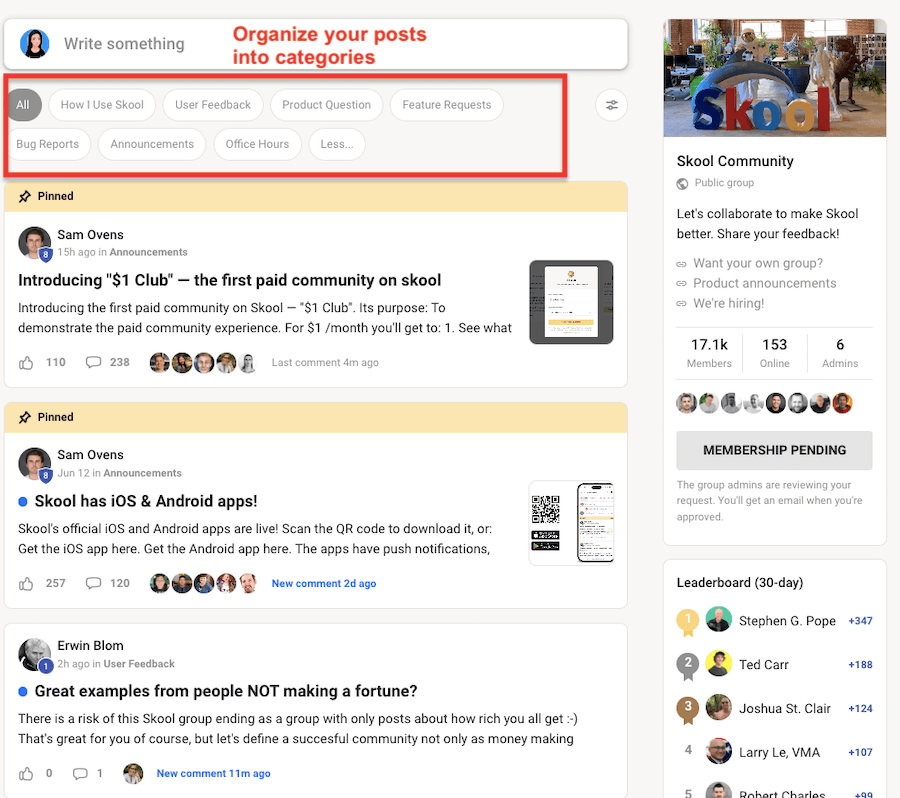
Though you can’t have your own white-labeled community, Skool offers everything you need and more. It’s not just about looks; it’s packed with substance and ease of use for the members as well as the admin.
Explore Skool’s Online Course Feature
After reviewing some of the best online course platforms, we can confidently say that Skool has one of the simplest course builders.
With just a few easy steps, you can get started: enter your course name, write a description, and add a cover image. That’s it. No need to be tech-savvy to create your courses on Skool; it’s designed to be user-friendly for everyone.
You can also decide who gets access. It could be:
- All members can have access
- Only some members have access
- Members of a certain level can have access
Now you can start by adding modules to your course.
You can add as many modules as you want to your course. Just copy one module or make a new one from scratch. To rearrange them, simply drag and drop the modules to put them in the order you like.
And if you have multiple modules or a complex course that needs further organization, no worries. You can group modules together by creating sets. This way, you can easily categorize and arrange your course content, ensuring a smooth learning experience for your learners.
You’ll have the option to include video content, descriptions, action items (things you want course viewers to complete), and a discussion section in every module. Additionally, you can use third-party tools to add lesson transcripts for better comprehension.
Also, note that Skool doesn’t offer video hosting for now. Still, you can easily use it in tandem with popular video hosting platforms like YouTube, Loom, Wistia, or Vimeo by simply adding video links.
However, this setup has its pros and cons.
If you look at the positive side, using external video hosting platforms means you have immense flexibility and control over your content. You can also leverage the advanced features and analytics exclusive to these video hosting platforms.
However, the downside is that managing content on one platform and publishing it on another can be cumbersome for some creators.
If you’re in the latter category, there’s good news.
According to a post from Sam Owens a few months ago, the Skool team is actively considering implementing native video hosting.
Besides video content, Skool features a straightforward (read: basic) course editor that allows you to add text-based content to your courses. You can add static images, gifs, and transcripts and make simple edits like adjusting headlines to H1, H2, etc., and apply text formatting like bold and italic styles.
Skool also supports timestamps but only if you embed content from YouTube, Wistia, or Vimeo. It’s a handy feature if you want to provide specific time references to your learners, helping them navigate to relevant sections right away.
This is what the finished course will look like to your viewers:
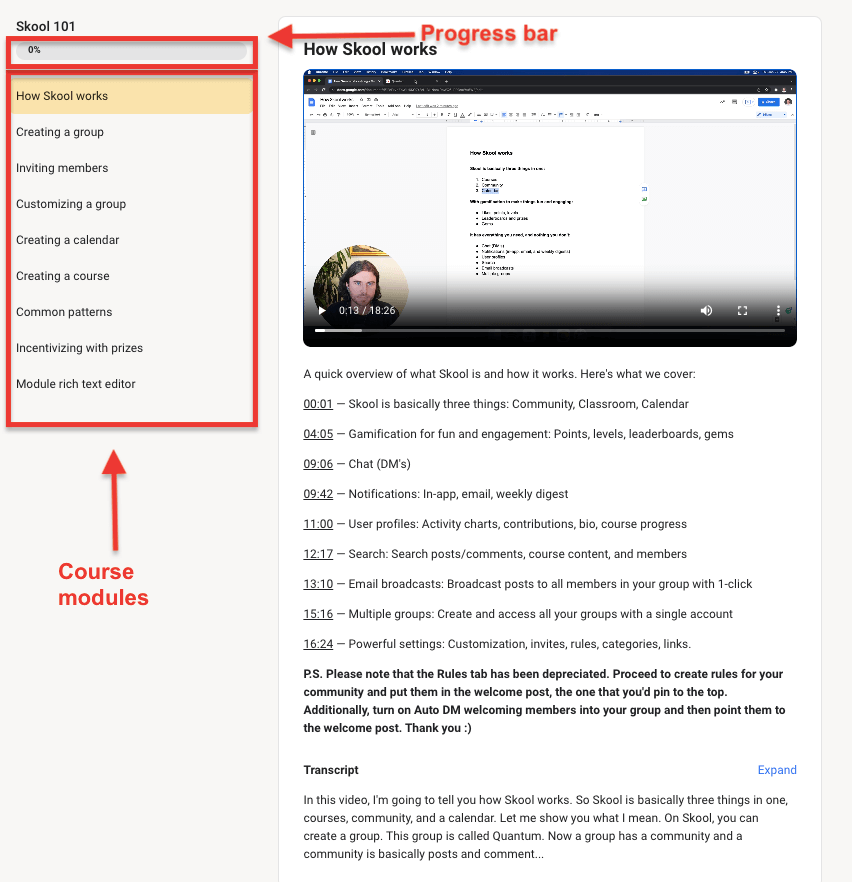
While Skool’s course builder might not have all the customization features you’ll get in a dedicated LMS platform like Thinkific, it still provides enough tools to create a straightforward course.
One drawback you’ll notice with Skool is that you can’t sell courses in the traditional way. Instead, monetization is linked to your community and its members. You can only choose to give course access to all members, specific individuals, or members at a particular level.
If you do want to earn from your online course, one workaround is to charge for group access and provide course access exclusively to those group members. It’s a different approach, but it can still be a successful way to make your course profitable.
Rewards and Incentives Galore: Skool’s Gamification Features
Since Skool is primarily a community platform for creators, they take engagement seriously. They incorporate a plethora of incentive and gamification elements to encourage member contribution and participation within the community.
These elements include:
- Points and levels
- Leaderboards
- Prizes
- Gems
First, you have the points system, which are similar to digital high-fives.
Members earn them whenever another member likes their posts or comments in the community. It’s simple: 1 like = 1 point.
As members earn points, they level up.
This inspires members to share top-notch content and also motivates other members to engage with the community and level up.
You can use these elements to encourage members to explore your courses too. For example, you can grant access to specific modules when members reach certain levels.
It’s a win-win situation – you boost engagement, and your members gain access to valuable content as they progress.
Skool’s community also showcases leadership based on points earned by its members.

Another incentive-based feature is awarding gems to high-value content. Gems make posts and comments stand out, drawing more likes and boosting the contributor’s level and visibility on leaderboards.
Skool further helps you engage your community members by allowing you to send them prizes. When you give small prizes to top contributors, and they thank you publicly in the community, you make them feel special and create a positive atmosphere that motivates others to join in.
Seamless Event Management: Explore Skool’s Calendar Feature
Another community-centric feature that Skool offers is its built-in calendar. It’s especially handy if you want to inform all the community members about an upcoming event.
From scheduling a webinar workshop to planning a group hangout, Skool’s calendar feature makes it easy to create and share events with your community.
You can configure settings like time zone, how long the event will go on, what it’s about, and when it’s going to occur. You can also set it as a one-time or recurring event.
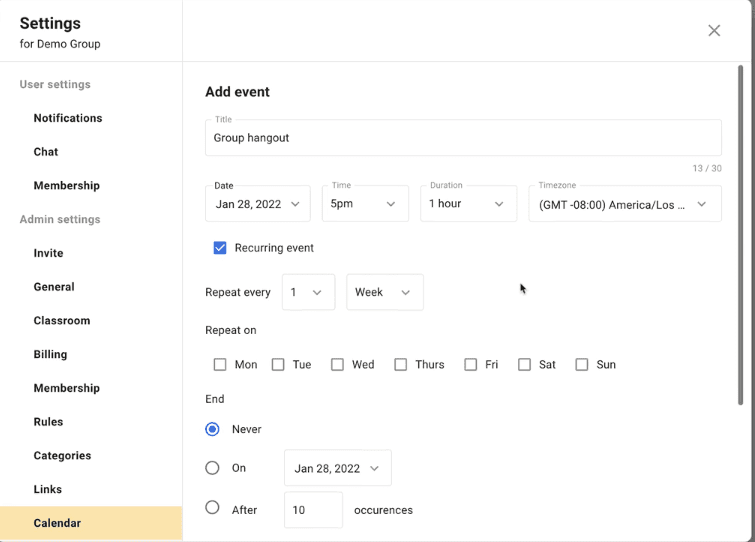
Once it’s all set up, here’s how it will appear in your member’s dashboard:
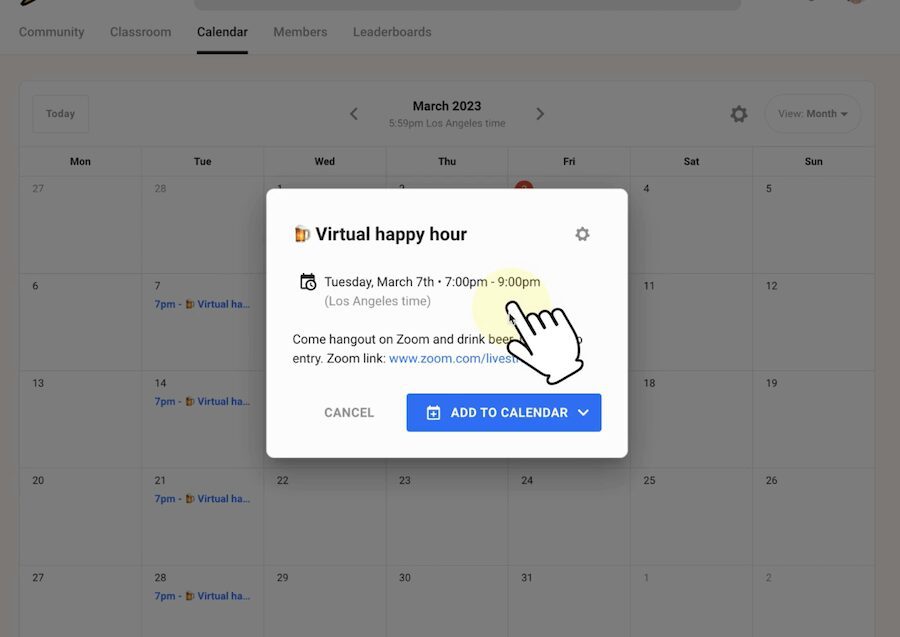
Note the members will see when the event is happening in their local time zone.
Zapier and Webhooks Integration
Skool lacks native integrations with third-party tools, but it does offer compatibility with Zapier and Webhooks.
This opens up vast possibilities for creators. While Zapier enables easy data transfers between Skool and other applications, Webhooks helps you trigger actions in Skool based on external events, streamlining workflows, and enhancing the platform’s functionality.
Skool User Interface & Ease of Use
We’ve reviewed multiple online community and course platforms, and Skool definitely stands out in terms of user-friendliness. You’ll realize this within the first few minutes of using it.
There’s no learning curve; everything from creating a community, inviting members, publishing posts, to building courses is a breeze and accomplished in just a few steps.
On both the viewer’s and the creator’s side, navigating through the platform is straightforward, making it easy for everyone to create and consume content. The course builder is refreshingly simplistic, allowing course creators to add various types of content, including images, videos, links, PDFs, and transcripts, without any complexities.
Its community builder is one of the key ways that Skool shines. When you join a community or build your own, it looks similar to a Facebook group feed.
Users can create groups to engage in discussions, share insights, and interact with other community members. The gamification elements, like points and leaderboards, add an element of fun and motivation, encouraging participation and recognizing top contributors.
We talked to Ilam Padmanabhan, who has 20 years of experience in the Tech industry and uses Skool as a part of his blogging course community.
Padmanabhan shares his experience with Skool’s community platform,
“I like Skool as it gives me a ‘Facebook like’ feed, but only with content I want to see. It is a great alternative to addictive social media. In addition, the ‘classroom’ options + integration with scheduling apps, etc., make it super easy to work with an online student community.”
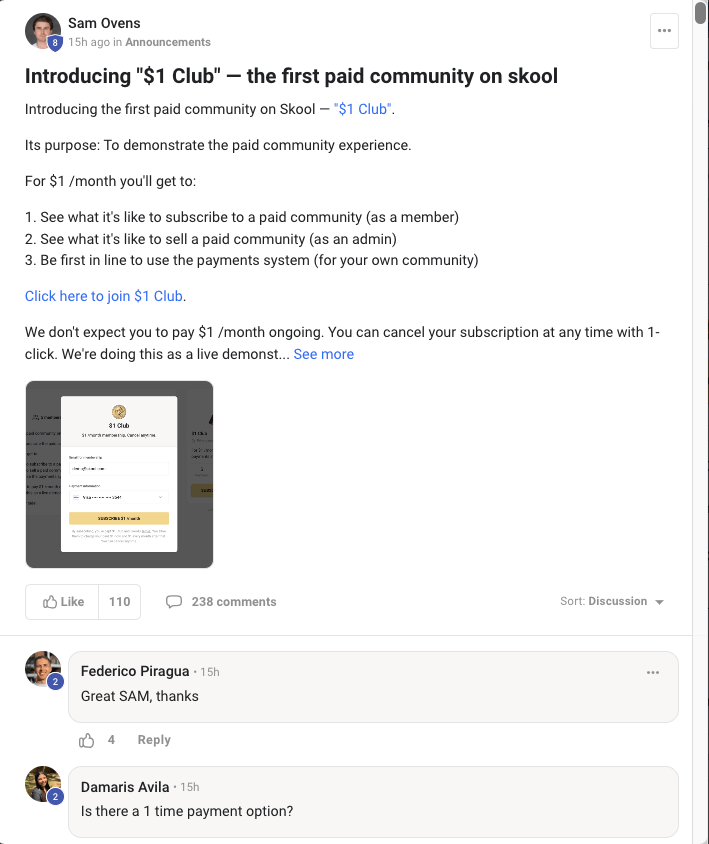
John Pennypacker, VP of Sales and Marketing at Deep Cognition, is also of the same opinion.
He also shared his experience with Skool with us,
“When entering Skool, it’s immediately apparent that great care has been taken to make it as easy to use as slick as possible. The back-end interface is straightforward and concise and resembles what your end-user (i.e., your students) will see:
The simple tabs at the top make it simple to browse the platform’s various components and functionalities.
The panel on the right side, which includes basic information and helpful links to get started, allows new members to understand what your community is about quickly.
Skool significantly fulfills its promise to provide straightforward methods for integrating a community and courses into a single direct platform.”
Skool Customer Support
Skool has responsive customer support, with their support team always ready to help out in the Skool community. You just have to post your query in the group, and one of the admins will assist you through chat or regular discussion. Other members of the community often join the discussion to share their insights too.
Additionally, you can reach out to the direct tech support team via email at [email protected].
Skool All-Inclusive and Transparent Pricing
Skool comes with a simple plan that encompasses every feature that the platform offers.
It’s going to cost you $99 per month for one group, all features, unlimited courses, and unlimited members.
You also get a 14-day free trial that you can cancel anytime you want.
Skool Pros and Cons: Weighing the Upsides and Downsides
| Pros | Cons |
|---|---|
| Skool has no steep learning curve; you can start creating your community and course without any help within minutes. | Course monetization in Skool is tied to the community and gamification points, making it unsuitable for traditional course selling. |
| Skool’s major focus is building engaging learning communities where members and creators can interact, collaborate, and support each other. | Skool doesn’t host video content, which could be a downside if you’re looking for a more centralized approach to course materials. |
| Gamification elements like points and leaderboards incentivize member participation and make learning fun. | As with any growing platform, Skool still has some features in development. |
| Integration with popular video hosting platforms enhances course delivery. | The platform doesn’t offer extensive customization options for those seeking more control over branding and appearance. |
| The built-in calendar helps creators keep members in the loop about upcoming activities. | |
| If you ever get stuck with the platform or want to request a new feature, you can post your query in the Skool community and get immediate help from the Skool team as well as from other Skool users like you. |
Exploring Skool Alternatives: Other Platform Options to Consider
While Skool is a great community platform, its simplistic approach might not be everyone’s cup of tea. In that case, you’ll want to weigh your options and see if there are community platforms that suit your needs better.
Here are some alternatives to Skool that you can consider:
1. Mighty Networks
Just like Skool, Mighty Networks helps you create and sell your communities and courses and host events. They also have rich member profiles in common.
But that’s where the similarities end. Skool excels in gamification elements, simplicity, video/audio transcripts, and action items.
On the other hand, Mighty Networks has an edge in terms of native video hosting and native live streaming services. You’ll also get access to “space templates” to create attractive community spaces for different purposes.
Plus, if you want to build communities that members can access on the go, then Mighty Networks is a great choice with its white-labeled Android as well as iOS apps. This is another area where Mighty Networks get a point over Skool.
Pricing: Mighty Networks starts at $33 per month but only for community features. If you want to build courses as well, it starts at $99 per month.
Check out this in-depth Mighty Networks review to learn more.
2. Circle.so
Circle is another community platform to help you build courses and communities and organize events under a single dashboard.
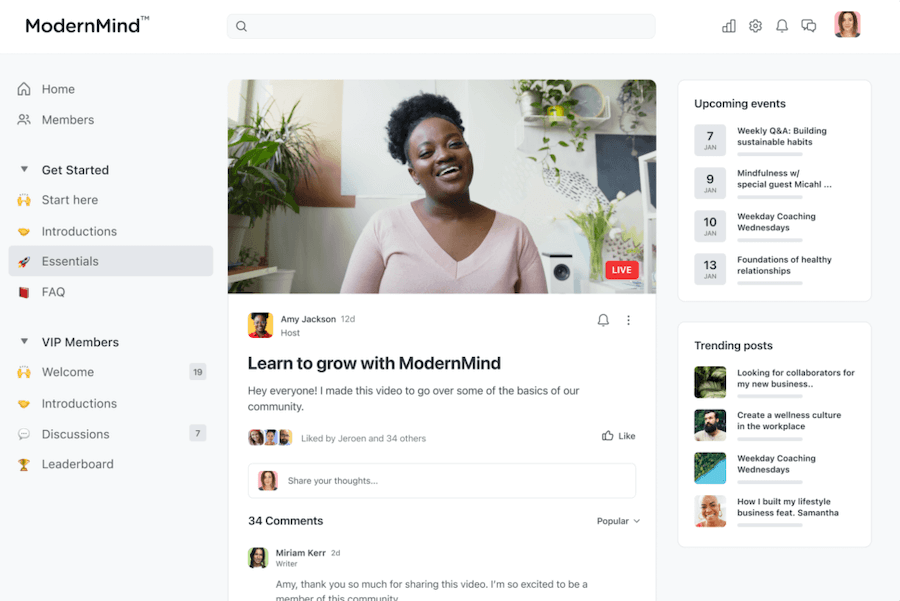
What gives Circle an edge over Skool is its ability to monetize courses and communities by offering membership tiers, one-off access, or a free trial.
You’ll also get access to student engagement features like 1:1 coaching programs, the ability to host live broadcasts, group chat rooms, and weekly digests. And Circle’s Community AI feature leverages artificial intelligence to elevate engagement and content.
However, until recently, Circle was primarily a community platform, so it lacks some course-centric features.
Pricing: Starts at $49/mo + 4% transaction fee.
To determine if it’s the right community platform for you, check out our detailed review of Circle.so.
3. Thinkific
Thinkific is the OG online course and membership platform with features to create learning communities as well.
Naturally, Thinkific’s primary focus is on course creation, management, and selling. On the other hand, Skool emphasizes community building and member interaction.
With Thinkific, you’ll get access to native video hosting, multiple course creation themes, and more customization options. On the monetization front, Thinkific lets you offer various pricing models, including one-time purchases, subscriptions, and payment plans.
However, Skool emerges on top if your primary goal is to run a community and promote your course using a community of engaged members.
Pricing: Plans start at $36 per month. Plus, Thinkific offers a freemium plan and a 30-day free trial on all paid plans.
If you’re still unsure, you might want to read this Thinkific review before making the final decision.
4. Kajabi
Kajabi is truly an all-in-one platform for course creation, coaching, membership sites, podcasts, and communities. It also offers advanced features like an email marketing system, a landing page builder, and sales funnels to help you market and sell your courses.
When it comes to building communities, Kajabi offers features like live video sessions, accountability tools, real-time chat, event management, and custom landing page embedding.
And while the gamification features aren’t as extensive as Skool, it does offer leaderboards and challenges.
Again, it comes down to your priorities. If you want all the bells and whistles to go with your community and course platforms, Kajabi is your friend. But if you want to build a simple learning community, look no further than Skool.
Pricing: Plans start at $119 per month billed annually or $119 monthly. There’s no freemium plan or even a free trial.
For a more detailed insight into Kajabi, check out our comprehensive Kajabi review.
5. Teachable
This list would have been incomplete without Teachable.
Not just Skool, Teachable is often billed as one of the top alternatives to Thinkific as well.
It allows you to create and monetize courses, coaching sessions, and other downloadable content. However, when it comes to creating communities, you’ll have to take advantage of its native integration with Circle.so. It doesn’t allow you to create a community on its own.
But if your sole purpose is to make money selling courses and create a community as an extension of your course, a tool like Teachable would be more suitable. It has advanced features to help you sell your courses, like built-in email marketing, the ability to host 1:1 coaching sessions, multiple monetization options, and quizzes. It also has a mobile app that allows learners to access your content on the go.
However, keep in mind that using Teachable with Circle.so means you’ll have to pay for both tools separately. So, if you have a sizeable budget and want to create and sell a fully customizable with a community, you can consider this option. Otherwise, you should stick to Skool.
Pricing: Teachable starts at $59 monthly (or $39/month with an annual subscription) + 5% transaction fee.
Read our full Teachable review to learn more.
Final Thoughts: Embrace the Learning Revolution with Skool
In a nutshell, Skool is a community-centric platform for educators, course creators, and community builders looking to bolster engagement and community interaction.
We’d recommend you consider Skool if:
- You want to promote your course or a product in a vibrant community.
- You want to incentivize participation and reward active contributors with gamification elements like points, gems, and leaderboards.
- You frequently host events and want to keep your community members well-informed about upcoming activities and schedules.
- You’re okay with paying an extra amount for Wistia/Loom/YouTube/Vimeo since Skool doesn’t support video hosting.
On the other hand, Skool might not be suitable if:
- You’re a course creator and want to sell traditional, branded courses with varied learning tools and monetization options. Remember that Skool’s monetization options are tied to the community.
- You want to sell a highly customized course or community.
- You need native video hosting.
All in all, Skool is an excellent choice if your aim is to create dynamic, interactive learning environments. But if you’re looking for more customization options or more comprehensive course creation features, we suggest you look for alternatives.
Table of Contents









